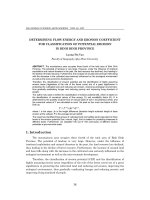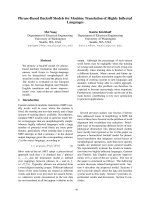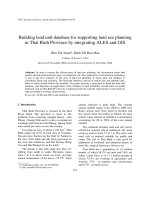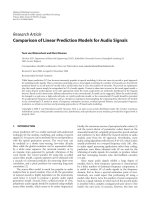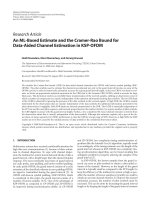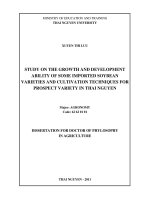Biomass and carbon sequestration prediction models for acacia mangium willd plantations in thai nguyen province, viet nam
Bạn đang xem bản rút gọn của tài liệu. Xem và tải ngay bản đầy đủ của tài liệu tại đây (3.37 MB, 227 trang )
UNIVERSITY OF THE PHILIPPINES LOS BAÑOS
Doctor of Philosophy in Forestry: Forest Resources Management
HUNG TUAN NGUYEN
BIOMASS AND CARBON SEQUE STRATION PREDICTION
MODELS FOR Acacia mangium Willd PLANTATIONS
IN THAI NGUYEN PROVINCE, VIET NAM
TEODORO R. VILLANUEVA, Ph.D.
Adviser
Date: ___________________________
This dissertation can be made available to the general public
YES
This dissertation can be accessed only after consultation with the
author and dissertation adviser
---------
This dissertation can be accessed only by those bound by confidentiality
agreement
---------
.
__________________________________
HUNG TUAN NGUYEN
__________________________________
TEODORO R. VILLANUEVA, Ph.D.
BIOMASS AND CARBON SEQUE STRATION PREDICTION
MODELS FOR Acacia mangium Willd PLANTATIONS
IN THAI NGUYEN PROVINCE, VIET NAM
HUNG TUAN NGUYEN
JULY 2018
The dissertation attached here to, entitled “BIOMASS
AND
CARBON
SEQUESTRATION PREDICTION MODELS FOR Acacia mangium
Willd PLANTATIONS IN THAI NGUYEN PROVINCE, VIET NAM ”
prepared and submitted by NGUYEN TUAN HUNG
in partial fulfillment of the
requirements for the degree of DOCTOR OF PHILOSOPHY (FORESTRY: FOREST
RESOURCES MANAGEMENT) is hereby accepted.
WILFREDO M. CARANDANG
Member, Advisory Committee
__________________________
Date Signed
JUAN M. PULHIN
Member, Advisory Committee
__________________________
Date Signed
MYRNA G. CARANDANG
Member, Advisory Committee
__________________________
Date Signed
TEODORO R. VILLANUEVA
Chair, Advisory Committee
__________________________
Date Signed
Accepted in partial fulfillment of the requirements for the degree of DOCTOR OF
PHILOSOPHY (FORESTRY: FOREST RESOURCES MANAGEMENT).
MARGARET M. CALDERON
Director, Institute of Renewable Natural Resources
__________________________
Date Signed
JOSE V. CAMACHO, JR
Dean, Graduate School
University of the Philippines Los Baños
__________________________
Date Signed
BIOGRAPHICAL SKETCH
The author was born on March 29, 1980 in Thai Nguyen City, Thai Nguyen
Province, Vietnam. He is the eldest of two children of Mr Nguyen Van Hoi and Mrs
Nguyen Thi Nhan. He finished his elementary, secondary, and high school education
from Thai Son, Quang Trung, and Luong Ngoc Quyen School, respectively in Thai
Nguyen City, Thai Nguyen Province, Vietnam in 1998.
He completed his bachelor‟s degree in Forestry from the Thai Nguyen University
of Agriculture and Forestry (TUAF), Thai Nguyen City, Thai Nguyen Province in 2002.
Through the Australia Development Scholarship (ADS), he was able to earn his Master‟s
degree in Forest Science and Management at the Southern Cross University, New South
Wales, Australia in 2012.
In 2015, the Southeast Asian Regional Center for Graduate Study and Research in
Agriculture (SEARCA) granted him a scholarship to pursue his PhD degree in Forestry:
Forest Resources Management at the College of Forestry and Natural Resources,
University of the Philippines Los Banos (UPLB).
He is currently employed as a teacher and researcher at the Faculty of Forestry,
Thai Nguyen University of Agriculture and Forestry, Thai Nguyen Province, Vietnam.
He is happily married to Ms. Pham Thi Hoai, with whom he is blessed with a son,
Nguyen Lam Khoa and a lovely daughter, Nguyen Tue An.
HUNG TUAN NGUYEN
iii
ACKNOWLEDGMENT
First and foremost, my sincerest thanks to my institution, Thai Nguyen University
of Agriculture and Forestry for allowing me to go on study leave and to the Southeast
Asian Regional Center for Graduate Study and Research in Agriculture (SEARCA) for
awarding me a scholarship to pursue a PhD degree in UPLB.
Special thanks are extended to Dr. Teodoro R. Villanueva, Chair, advisory
committee, for his intellectual and professional guidance, critical comments,
encouragement and remarkable interest in supervising this study. My grateful
acknowledgment also to the members of my advisory committee: Dr Myrna G.
Carandang, Dr Wilfredo M. Carangdang, and Dr Juan M. Pulhin for their valuable
comments, sincere concern, and understanding.
I am also thankful to the rest of the faculty and administrative staff of the Institute
of Renewable and Natural Resources and the Faculty of UPLB Graduate School for their
great support.
A note of gratitude also goes to all the members of the Faculty of Forestry, Thai
Nguyen University of Agriculture and Forestry for the support and assistance extended to
me for my study. My deepest gratitude goes to my loving family for all their sacrifices and
encouragements. I am forever grateful to my loving wife, Mrs. Pham Thi Hoai, my son,
Mr. Nguyen Lam Khoa and and my daughter Ms Nguyen Tue An for their love and
spiritual support.
Special thanks also go to all of my sincere friends in Vietnam, as well as in UPLB
who have directly or indirectly helped me during my stay at UPLB and also during the
conduct of dissertation research in my country.
iv
TABLE OF CONTENTS
CHAPTER
I
II
PAGE
Title Page
i
Approval Page
ii
Biographical Sketch
iii
Acknowledgement
iv
Table of Contents
v
List of Tables
ix
List of Figures
xi
Abstract
xiv
INTRODUCTION
1
Background of the Study
1
Statement of the Problem
8
Hypothesis of the Study
12
Objective of the Study
13
Importance of the Study
14
Scope and Limitation of the Study
17
REVIEW OF LITERATURE
18
Biomass and Carbon Sequestration of Forest Ecosystems
18
Studies on Biomass and Carbon Sequestration in the World
23
Studies on Biomass and Carbon Sequestration in Vietnam
27
Studies on Biomass and Carbon Sequestration
Studies on Biomass and Carbon Sequestration of Acacia Species
in the World
v
31
31
CHAPTER
PAGE
Studies on Biomass and Carbon Sequestration of
species in Vietnam
Acacia
Biomass and Carbon Prediction Techniques
III
33
36
Aboveground Biomass
37
Below Ground Biomass (BGB)
39
Biomass Growth Models in Forest Management
41
Estimation of Total Aboveground Biomass and Carbon Storage
based on IPCC Method
50
Estimation of Total Aboveground Biomass and Carbon Storage
based on the Jenkins et al. (2003) Method
50
Estimation of Total Aboveground Biomass and Carbon Storage
based on the Chojnacky and Jenkins (2010) Method
51
METHODOLOGY
55
Study Area
55
Data Gathering Techniques
58
Analytical Framework
59
Mapping of Study Site
62
Sample Size and Sampling Method
63
Tree Volume
65
Basal Area of Stand
66
Stand Density
67
Mean of Diameter
68
Mean Total Height
68
Aboveground Biomass (AGB) Calculation from Volume
69
Biomass and Carbon Estimation of Individual Trees
Individual Trees Biomass Estimation
vi
70
70
CHAPTER
PAGE
Methods to Determine theAmount of Carbon Stored in the
Plantation
IV
75
Data Analysis and Model Development
77
Model Application and Validation
85
RESULTS AND DISCUSSION
87
Acacia Plantation Management in Thai Nguyen Province
87
Description of the Study Area
91
Descriptive Statistics for All Variables of the Study
92
Stand Variables
92
Sample Variables
98
Biomass and Carbon Estimation of Sample Tree and Stand
104
Green Biomass of Individual Tree and Stands
105
Dry Biomass and Carbon of Individual Trees and Stands
116
Percentage between Dry and Green Biomass for Sample Tree by
Age
122
Carbon and Carbon Dioxide Stock of Individual Trees and
Stands
123
Total Aboveground and Belowground Biomass Estimation
128
Model Development, Selection and Evaluation for Biomass Estimation
131
Tree Fresh Biomass Models by Separated Ages
134
Bole Biomass Models by Separated Ages
144
Biomass Models of Branch and Leaves Combination by
Separated Ages
151
Green Biomass Models for all Age Levels
159
Dry Biomass Models by Separated Ages
161
vii
CHAPTER
PAGE
Dry Biomass Models for All Age Levels
169
Carbon Prediction Models by Separated Ages
171
Carbon Estimation Models for All Age Levels
178
Carbon and Carbon Dioxide Stock for Present Land Use and Scenarios
Plantation Management in Thai Nguyen Province
V
180
Carbon and Carbon Dioxide Stock of Present Land Use of
Acacia mangium Willd
180
Scenario 1. Land Use Change
181
Scenario 2: Trend in biomass and carbon of Acacia mangium
Willd Plantation
182
SUMMARY, CONCLUSIONS, AND RECOMMENDATIONS
186
Summary
186
Conclusion
188
Recommendation
191
LITTERATURE CITED
194
viii
LIST OF TABLES
TABLE
PAGE
1
Estimated belowground biomass and carbon models for evergreen forests in
Central Highlands of Vietnam.
41
2
The estimated biomass models built for the forest types over the world.
52
3
The estimated above ground biomass models built for forest types in
Vietnam.
53
4
Inventory data sheet for each sample plot.
65
5
Green biomass calculated from the sample plots.
72
6
Dry biomass calculated from the sample plots
74
7
Forest resources of Thai Nguyen Province.
89
8
Descriptive summary of stand variables of Acacia mangium Willd.
93
9
ANOVA test of diameter and tree height at different strata conditions.
86
10
Descriptive statistics for sample trees of Acacia mangium Willd by ages.
101
11
Average green biomass distribution in the tree (kg/tree).
106
12
Dry biomass of sample trees by age.
118
13
Proportion of dry weight over green weight by age.
122
14
Average carbon and carbon dioxide of sample trees and components.
124
15
Aboveground and belowground biomass estimation from existing equations
130
16
Biomass model parameters and their performance criteria for Whole-trees.
135
17
Selection of best models for whole-trees biomass estimation by age.
136
18
Actual and predicted biomass for whole-tree by age.
140
19
Bole biomass model parameters and their performance criteria for different
age.
145
20
Selected models for bole biomass estimation by ages for Acacia mangium
Willd.
146
ix
TABLE
PAGE
21
Comparison between actual and predicted bole biomass for the best
equations.
147
22
Models for combined branch and leaves of Acacia mangium Willd by ages
of plantation.
153
23
Selected models for biomass prediction of branch and leaves combined.
154
24
Actual and predicted values of biomass for branch and leave combined
(kg/tree).
155
25
Green biomass models tested for all age classes of Acacia mangium Willd.
Equation in bold font was selected as best model for biomass prediction.
160
26
Total dry biomass equation tested with predicted variables at different age.
163
27
The best selected dry biomass equations with predicted variables by age.
164
28
Actual and predicted dry biomass by age.
165
29
Dry biomass model tested for all age classes of Acacia mangium Willd. The
equation in bold font indicates the best models for dry biomass prediction.
170
30
Tree carbon prediction models, parameters, and their performance criteria.
173
31
The best selected equations for carbon prediction by age.
174
32
Comparison of actual and predicted carbon sequestration of whole-tree by
age.
175
33
Carbon model tested for all age classes of Acacia mangium Willd. Model 4
(D*H) in bold font, was selected as the best model for carbon prediction.
179
34
Current total carbon sequestration and three scenarios that happened.
182
35
Biomass, carbon, and carbon dioxide trend values
183
x
LIST OF FIGURE
FIGURE
PAGE
1
Estimated US atmospheric CO2 mitigation requirements and potential
sequestration capacities (Sundquist et al., 2008).
2
2
The global carbon cycle. Fluxes shown are approximate for the period
2000-2005, as reported by the IPCC (Sundquist et al., 2008).
20
3
Principal global carbon pools. Soil organic carbon (SOC) and soil inorganic
carbon (SIC) are two different forms of carbon that can be stored in the soil
(Lal 2004a).
20
4
Five carbon pools in the forest ecosystem.
22
5
Circle plot used in America.
38
6
Map of Thai Nguyen Province.
57
7
Analytical framework of Acacia mangium Willd biomass and carbon
model.
61
8
Temporary sample plot of Acacia mangium Willd plantation.
63
9
Sample plots sketch out in the Acacia mangium Willd plantation.
64
10
Sample trees felled and weighed for green biomass in the field.
71
11
Samples for dry biomass were calculated from green biomass.
73
12
Maps showing location of the study site.
92
13
Average diameter and total height of Acacia mangium Willd at different
strata conditions by age.
97
14
Sample tree variables of Acacia mangium Willd by age.
103
15
Green biomass (kg/tree) changed by ages of sample trees at the different
strata (A, B, C, D). Average at bottom, side, and top biomass of the strata,
respectively).
108
16
Biomass distributions in the tree components by ages (%).
110
17
Average of green biomass by sample tree and stand by age.
113
18
Correlation analysis of plantation age and green biomass.
114
xi
FIGURE
PAGE
19
Correlation analysis of relationship of total green biomass and diameter and
height.
115
20
Dry biomass (kg/tree) changed by ages of sample trees at the different
strata (A, B, C, D are average, bottom, side and top biomass of the strata
respectively).
119
21
Dry biomass distribution in sample tree components (%) by age.
120
22
Average dry biomass of Acacia mangium Willd sample trees (kg/tree) and
stand (ton/ha) in Thai Nguyen Province.
121
23
Correlation analysis of log-transformation of D, H and dry weight of
Acacia mangium Willd sample trees in all age levels.
121
24
Average carbon and carbon dioxide of sample trees and stands.
125
25
Correlation analysis of Acacia mangium Willd plantation age and carbon
stock.
128
26
Actual versus predicted whole-tree biomass using the best equations for
separated different ages. The R2 value indicates the goodness of fit for
fitted regression line
142
27
Actual and predicted whole-tree biomass using the best equations for all
age levels. The R2 value indicates the goodness of fit for fitted regression
line.
145
28
Relationship between actual and predicted biomass of sample tree bole
(kg/tree) by age.
150
29
Average actual vs predicted biomass of sample trees for every year of
plantation.
151
30
Tested actual and predicted biomass by ages using linear regression scatter.
158
31
Residual analysis plotted of all sample trees for the best selected models
161
32
Correlation analysis between measured and predicted dry biomass by age.
168
33
Correlation analysis between whole-tree dry biomass and diameter, total
height.
169
34
Residual analysis plots for all dry biomass of sample trees for the best
selected model.
170
35
Correlation analysis between actual and predicted carbon stock by age.
177
xii
FIGURE
PAGE
36
Correlation between whole-tree carbon with diameter and total height of
sample.
178
37
Residual plotted analysis of all sample trees for the best selected models.
180
38
The trend of biomass and carbon of Acacia mangium Willd in Thai
Nguyen.
184
xiii
ABSTRACT
Hung Tuan Nguyen, University of the Philippines Los Banos, July 2018. Biomass and
Carbon Sequestration Prediction Models for Acacia Mangium Willd Plantations in
Thai Nguyen Province, Vietnam.
Major Professor: Dr Teodoro R. Villanueva
The study developed a model to estimate current biomass and carbon stocks as well as
predict future biomass and carbon sequestration potential for forest plantations of Acacia
mangium Willd in Thai Nguyen Province, Vietnam. Specifically, the study: 1) characterized the
Acacia mangium Willd plantation in Thai Nguyen Province, Vietnam; 2) estimated the current
biomass and carbon stocks of tree and stand for Acacia mangium Willd plantations; 3) developed
a biomass and carbon models for tree of Acacia mangium Willd; 4) determined the future
conditions of plantation based on the programs and policies of the government; and 5)
recommended appropriate management strategies to improve the forest plantation development
and management.
A total of 126 plots representing various ages of plantations were established at the
bottom, hillside, and hilltop of the plantation. Data collected from each plot included age of
plantation, spacing, density, diameter, total height, basal area, and volume. Estimates of the
various plantation characteristics showed significantly higher values in the bottom compared with
those in the other parts of the plantations sampled.
The data for biomass and carbon estimation and development of prediction model came
from 54 destructive sampled trees of different diameter classes (big, medium, and small) of the
different ages. Six candidate non-linear regression equations using variables as diameter, total
height, and age of plantation were tested and assessed for statistical validity and accuracy in
biomass and carbon prediction. Data analysis was carried out in Excel and STATA 14 PM
software. The study showed that the major biomass and carbon of tree are boles, followed by
branches and leaves. Biomass and carbon models were tested for separated ages (each age class
was tested by the model), as well as all age levels from ages 2 to 7 Acacia mangium Willd
plantation (all age classes from 2 to 7 were tested by the model). In terms of separated ages, the
model with one variable as diameter (D) showed the better values than variable height (H) and
two variables (D, H) combined due to the high correlation efficiency (R2), small standard error
(SE), and higher F values. As for the models tested for all age levels combined with the addition
of the variable age (A), there was no significant difference observed between single predictor and
combined predictors. The accuracy of the values was tested by chi-square and residual analysis to
compare between observed and predicted biomass and carbon.
The prediction equations were used to assess future biomass and carbon sequestration in
the province. Scenarios of biomass and carbon change were assessed based on the programs and
policy of the government.
xiv
CHAPTER I
INTRODUCTION
Background of the Study
Climate change is one of the most pressing issues in the world today. Human
activities, especially the burning of fossil fuels, have caused an increased concentration of
carbon dioxide (CO2) in the atmosphere, which is a large contributor to climate change. It
is generally thought that reducing dependency on fossil fuels and using renewable
resources like biomass are ways that can reduce CO2 emissions (Adams et al., 2002).
Carbon sequestration in trees and soil as a means of minimizing atmospheric
carbon stores is a concept that has been undervalued as a means to help prevent global
climate change. However, it has been shown that forests and soils have a large influence
on atmospheric levels of CO2. Moreover, geologic sequestration and ocean sequestration
are also effective in CO2 storage (Adams et al., 2002).
Demand for carbon dioxide mitigation in the United States (such as carbon) and
potential absorption capacity: (1) Reducing CO2 emissions and CO2 emissions in the
United States to stabilize atmospheric CO2 at 550 ppm Model of the United States
Climate Change.. Science Program); (2) Estimated absorption capacity of the United
States (Figure 1). According to estimates by the US Department of Energy, an estimated
3,400 gigatons of carbon for potential geological reserves is equivalent to 12,600
2
gigatons of CO2). Uncertainty in the process of land and geological accumulation is
estimated to be significant (Sundquist et al., 2008).
Consequently, CO2 emissions from the combustion of fossil fuels are currently
greater than the uptake of atmospheric CO2 into terrestrial and marine sinks; thus, greenhouse
gases continue to accumulate in the atmosphere. Carbon sequestration must therefore become
a vital part of a comprehensive strategy to offset anthropogenic CO2 emissions and minimize
future climate change (Adams et al., 2002).
Figure 1. Estimated US atmospheric CO2 mitigation requirements and potential
sequestration capacities (Sundquist et al., 2008).
The report of IPCC in 2007 indicates that about 100 billion metric tons of carbon
over the next 50 years could be sequestered through forest management, which would
offset 10-20% of the world‟s projected fossil fuel emissions. These models indicated the
3
need to reduce annual global emissions by more than 75% during the next century in
order to stabilize atmospheric CO2 at about 550 parts per million (Sundquist et al., 2008).
For the US, McCarl and Schneider (2001) cited in Sundquist et al., (2008), suggested that
between 50 and 150 million metric tons of additional carbon sequestration per year could
be achieved through changes in agricultural soil and forest management. Enhancing the
natural processes that remove CO2 from the atmosphere is one of the most cost effective
means of reducing atmospheric levels of CO2 and cutting down dependency on fossil
fuels.
Currently, global warming is considered a major problem that is negatively
influencing organisms and ecosystems worldwide. Moreover, as a consequence of global
warming, climate change has brought about damages to all components of the
environment as evidenced by
rising sea levels, drought, changing microclimate,
increasing occurrence of different types of diseases, water shortage, decreasing
biodiversity, and increasing extreme weather phenomena (IPCC, 2000).
The climate change related to greenhouse gas emissions into the atmosphere
(mainly CO2) due to the economic activities of human society is a priority concern in
many countries all over the world. Thus, a study on CO2 sequestration will contribute in
stabilizing greenhouse gas concentrations in the atmosphere at a safe level and also
prevent damages on the earth‟s environment that are caused by human activities such as
forest fire, deforestation, illegal logging etc. Moreover, a study on carbon sequestration
and commercial value of forest carbon is an important part of the environmental value of
4
forests. This has become a demanding objective that cannot be delayed in order to put the
Law on Forest Protection and Development into practice (IPCC, 2000).
The amount of forest carbon sequestration depends on forest types, forest
conditions, species, and age levels. The current concern, however, is on how to estimate
and forecast the ability of forests to absorb carbon as an important key assessment to pay
for environmental services (PES) (Bui Hien Duc, 2014).
Vietnam and 160 countries around the world have adopted and signed the
Framework Convention of the United Nations on Global Climate Change (UNFCCC)
which was confirmed by the Kyoto Protocol in 1997. The framework aims to establish a
legally binding protocol on greenhouse gas emission reductions for developed countries
and come up with mechanisms to help developing countries achieve socio economic
development
in a sustainable manner through the implementation of the "clean
development mechanism" (CDM). CDM has opened up great opportunities for the
forestry sector in the trade of carbon accumulation by the forest ecosystem to create
livelihoods for people and reinvest development (Prime Minister 2010).
Vietnam‟s genuine interest on the issue of climate change has led it to become one
of the pioneering countries in Southeast Asia to apply payment for forest environmental
services. In 2008, the Prime Minister of Vietnam issued Decision No. 380/QD-TTg on
policies to pilot payment for forest environmental services.
Decision No. 380/QD-TTg
was piloted in two provinces, namely: Son La and Lam Dong (Prime Minister Decision,
2008).
5
In 2010, Vietnam Government issued Decree No. 99/2010/ND-TTg on policies
for forest environmental payments (Prime Minister, 2010). According to this decree,
organizations and individuals that benefit from forest environmental services have to pay
for forest environmental services to owners of forests that create supply services
including CO2 absorption and retention of forest carbon.
In 2014, the Ministry of Agriculture and Rural Development (MARD) issued
Decision No. 774/ QD dated 18-4-2014 -BNN -TCLN which aims to Approve Action
Plan to improve productivity, quality, and value of plantation production phase in 20142020 in order to develop large timber production plantation (MARD, 2014). In addition,
Vietnam Government continues to support large timber plantations with a higher fund
under Decision No. 147/2007 / QD-TTg dated 10-9-2007.
In the North East region where Thai Nguyen Province is located, the group
species for large timber production forests include Acacia species, Eucalyptus, Ficus
Religiosa, Pinus, Chukrasia tabularis, Canarium album Raeusch, Melia azedarach Linn.
In particular, Acacia species is still the dominant species selected for planting, accounting
for about 80% of the area (MARD, 2014).
According to MARD (2015), the forest area in Vietnam is close to 14.062 million
hectares including natural forests which account to more than 10.175 million hectares,
and more than 3,886 hectares of plantation. The area of forest cover reaches 39.5%, while
the area of perennial crops grown on forestland accounts to just over 1.3%. As a result,
6
plantation not only plays an important role in the forest sector of Vietnam in the future
but it also contributes to the carbon sequestration cycle as well.
Acacia mangium Willd has become one of the world‟s major plantation species
for pulpwood production. At least 1.5 million hectares in South East (SE) Asia are
planted with Acacia mangium Willd with Indonesia, Vietnam and Malaysia having the
largest areas, together with an additional 0.3 million ha of the A. Mangium x
auriculiformis hybrid which is grown in Vietnam (Chaw Chaw Sein, 2011).
Acacia is a large genus with over 1,300 species widely distributed throughout the
tropics and subtropics. Most species are found in the Southern hemisphere while the main
centre of diversity is located in Australia and the Pacific. Acacia is found, sometimes
dominant, in primary and secondary forest, forest margins, savannah, grassland, and
savannah woodland, on poorly drained floodplains, and along fringes of mangrove forest,
where it is sometimes associated with Melaleuca and Rhizophora spp (PROSEA, 1995).
Acacia mangium Willd is found in areas of high rainfall in Northern Australia,
New Guinea and some adjacent islands. The prevailing climate in these areas is usually
strongly seasonal, with rainfall of less than 50 mm/month in June–October, in contrast to
the average annual rainfall of 1,450–1,900 mm in Southern New Guinea, and 2,100 mm
in Northern Queensland, Australia (PROSEA, 1995).
Fast growing, nitrogen fixing, ever-green with phyllodes that serve as leaves
(NFTA, 1987), Acacia mangium Willd is a medium-sized to fairly large tree measuring
7
up to 35 m tall; its bole is branchless for up to 15 m, and can measure up to 90 cm in
diameter.
The bark‟s surface is fissured near the base and is greyish brown to dark brown in
colour; whereas the inner bark is a paler shade of brown. Branchlets are observed to be
acutely triangular, the phyllodes straight, or straight along one side and curved along the
other. These branchlets measure up to 25.0 x 3.5–9.0 cm and are 2–5 times as long and as
wide, with 4 or 5 main longitudinal veins, and the secondary veins finely anatomising.
Flowers possess five merous having a corolla 1.2–1.5 mm long. The pods of the tree are
broad, linear and irregularly coiled, measuring up to 10 x 0.3–0.5 cm when ripe. These pods
are membranous to slightly woody and inconspicuously veined (PROSEA, 1995).
Acacia mangium Willd
is an important multipurpose tree for the tropical
lowlands. It is one of the most widespread of the fast-growing tree species used in
plantation forestry programmes throughout Asia, the Pacific, and the humid tropics like
Vietnam (Chaw Chaw Sein, 2011).
Acacia mangium Willd has been playing an increasingly important role in efforts
to sustain a commercial supply of tree products whilst reducing pressure on natural forest
ecosystems. Fast-growing Acacia plantations provide industrial wood for Vietnam‟s
wood-processing, pulp and paper industries, and woodchip exports, as well as household
fuelwood supplies in rural areas. Currently, 80% of the total requirement of Vietnam‟s
wood-processing industries must be imported. Acacia plantations are also nitrogen fixing
8
species and its leaves provide an effective litter layer, making the species a favoured
plantation genus in Vietnam (Chaw Chaw Sein, 2011).
In Vietnam, the study of Acacia species entirely focuses on Acacia hybrid. This
present study focused only on the growth, the structure, tree composition, and current
biomass of Acacia magium Willd, particularly in Thai Nguyen Province where it
dominates almost all forest plantations. Existing prediction models that estimate the
current and future biomass and carbon sequestration potential of plantations were not
used in this study. Furthermore, the biomass and carbon estimation of Acacia magium
Willd plantation in Thai Nguyen Province, Vietnam were not tested in the consecutive
age levels.
Statement of the Problem
Characteristics of forest plantation, such as tree density, basal area, tree
frequency, stand height, species composition, and volume are part of any silvicultural
stand investigation. However, in various tree attributes, diameter and total tree height are
probably of the greatest importance (Kleinn et al., 2004) and are the most widely used
descriptors of biomass and carbon assessment. Diameter is, in most cases, easily and
directly measured to calculate the biomass and carbon sequestration of forest trees. In
forest inventory, total biomass and carbon of trees and stands can be estimated based on
diameter and total tree height.
9
Forests play an important role in the global carbon cycle. In tropical timberlands,
up to 50% of the carbon is found in vegetation and 50% in the soil (Dixon et al, 1994;
Brown, 1997; IPCC, 2000; Pregitzer and Euskirchen, 2004; Phan Minh Sang and Lưu
Canh Trung, 2006). This was one of the reasons for their inclusion in the Kyoto Protocol
(UNFCCC, 1997). Therefore, forests have the greatest potential for reducing CO2
emissions in the atmosphere (Brown, 1997; Munishi et al., 2000; Munishi, 2001; Munishi
and Shear, 2004).
Thus, elucidating on the potential of carbon sinks and the role of forest
ecosystems in the carbon cycle, measures to increase the contribution of forest
ecosystems in combatting global climate change is now of global scientists‟ interest.
The amount of carbon absorbed actually depends on forest types, forest
conditions, species, and age levels; however, the current concern is how to estimate and
forecast the ability of forests to absorb carbon as a basis to pay for environmental
services. These are the outstanding issues being researched in Vietnam especially in the
current period, when the area of planted forests is increasing. To encourage forest
investment units, a research that would quantify the environmental value of forests is
essential.
Estimates of biomass and carbon stocks and CO2 sequestration are important
information and inputs for monitoring the volatility of absorbing CO2 emissions in carbon
pools for each state of the forest types, and regions with different ecological conditions.
There are relationships between biomass, carbon and silvicultural investigation factors
10
(diameter at breast height (DBH), tree height (H)) and ecological factors, structural
factors such (forest species composition, basal area, density) which are important
variables for biomass and carbon estimation and prediction methods (Bao Huy et al.,
2012 cited in Bui Hien Duc, 2014).
Mathematical models for estimating biomass and carbon vary between sites and
species as a function of growth conditions and species composition. In recent years,
efforts to develop correlation equations from global to local equations have been
increasing in the tropics (Brown, 1997; Chave et al., 2005). However, the use of global
allometric equations can lead to significant errors in vegetation biomass and carbon
estimations compared to local equations due to the specific condition of the study areas.
In Vietnam, one model has been developed to quantify the amount of biomass
for some common species, including Acacia mangium Willd, for plantations based on
the ecological condition of the regions. Despite of the presence of allometric models for
estimation of biomass in Acacia mangium Willd in the country, the model cannot be used
yet in a wide range of specific conditions, ages, elevations, and soil types because of the
following reasons: 1) the allometric model was developed for the whole ecological
condition of the region and only focused on the biomass rather than on carbon model; 2)
the model was developed for different densities, site classes, and growth conditions of the
plantation; and 3) the model was based on plantation of 6 and 7 years of age which is
about the rotation age of the plantation in Vietnam.

